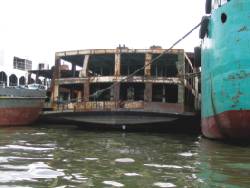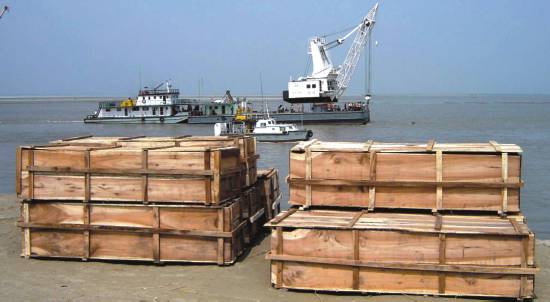|
Cover
Story

The recent launch disasters at Patuakhali and Aricha
epitomise the utter neglect that ails the river transport sector. After each capsize an uproar follows. Newspaper reports cry out for drastic measures to rectify the rules and restructure the system of design approval as well as for guarding against plying of unfit launches. However, while the relevant
authorities fail to carry out their respective tasks, the meagre budgetary allocation only shows that in the national agenda the water transport sector receives little attention.
While no one is lifting a finger to end the woes of the people, experts are of the opinion that this crippled sector needs a complete overhaul. And that is not a job of the relevant authorities alone. A lot depends on government policy itself.
Mustafa Zaman and Shamim Ahsan
Photographs: Zahedul I Khan,
Daily Star File Photo
 On May 19, two days after the disaster, the people that crowd the bank are anxious to find out the fate of their relatives. They are already resigned to the fact that there is little hope of seeing those who were in that doomed MV Raipura, alive. The wait for the dead is a long one as the current is strong and the means to retrieve the launch and the dead bodies are limited. The sunken launch could not be salvaged 27 hours after it sank. Eighteen divers of Bangladesh inland Water Transport Authority (BIWTA) rescue team started operations at noon. Due to strong currents they could not retrieve any dead bodies. They only identified the location of the sunken launch that lay forty feet below the surface. The rescue vessel MV Rustam, one of the two such vessels, arrived in the scene only in the evening to start operations the next morning. On May 19, two days after the disaster, the people that crowd the bank are anxious to find out the fate of their relatives. They are already resigned to the fact that there is little hope of seeing those who were in that doomed MV Raipura, alive. The wait for the dead is a long one as the current is strong and the means to retrieve the launch and the dead bodies are limited. The sunken launch could not be salvaged 27 hours after it sank. Eighteen divers of Bangladesh inland Water Transport Authority (BIWTA) rescue team started operations at noon. Due to strong currents they could not retrieve any dead bodies. They only identified the location of the sunken launch that lay forty feet below the surface. The rescue vessel MV Rustam, one of the two such vessels, arrived in the scene only in the evening to start operations the next morning.
The day after, Rustam's salvage operation was delayed because of heavy currents. By evening, 29 floating bodies were retrieved downstream from next to Char Maheshkhali near Aricha-Ghat, Manikganj. More divers joined in the rescue effort upping the total number to 22. According to a Daily Star report, one of the divers confirmed that there were more bodies trapped in the capsized launch but the tough current was making retrieval impossible.
Meanwhile, Rustam faced difficulties for the same reason. The metal wires that were being used to help re-float the launch snapped and new ones were ordered. The divers ordeal continued as did the trepidation of the awaiting relatives who hoped against hope that the bodies of their dear ones would be retrieved.
MV Raipura sank on the 17th with more than 200 passengers, and according to newspaper reports only 20 could swim to the shore on that fateful afternoon. And after three days, 17 more floating bodies were retrieved, and more than 150 were still missing. The wait for the bodies are a recurring nightmare. In fact the ill-fate of MV Raipura, from its sinking in a seasonal storm to the wait for the bodies to be salvaged, is like a story retold many times over. The river's strong currents eventually forced the salvage operation to be shelved on May 22, to the disbelief of the victims' relatives.
On May 16, Hamza, the other rescue vessel, arrived to rescue ML Prince of Patuakhali, the launch that had sunk in the Bura-Gourango on May 15 near Char Kajal, Patuakhali. By May 16, 31 dead bodies were recovered bringing the death toll to 44. On the evening of the same day the launch was lifted. More than a hundred were still missing. A rumour spread that the authorities were not disclosing the number of the dead. True or false, the local smelled a rat. People of the area and the relatives of the missing were enraged. The situation became so volatile that the locals police had to take action. They resorted to shooting rubber bullets. This was an incident where the bereaved behaved uncharacteristically and went into agitation. It only showed that they were at their tether's end. But this was not enough to send a massage to the relevant authorities, namely the Ministry of Shipping, BIWTA and Bangladesh Inland Water Transport Corporation (BIWTC).
 |
 |
| They know the risks of their journey but there are no alternatives. |
Sinking of vessels are causing an appalling number of deaths. It is something that has been plaguing the water transport sector for many years, but little has been done to reduce the risk. Standard safety measures have been a subject on which many reports have been penned but no headway made to upgrade the designs of vessels let alone the develop a modern warning system to facilitate smooth river transport. Over the last four years, the apathy has cost more than three thousand lives.
"If you consider the body counts you will see that the number of launch disasters has drastically increased in the last four years," Shahabuddin Milon puts things in perspective; he is the vice chairman of the Launch Owners' Association. The post-independent records support his claims. More than six thousands people have perished since 1971 and in the last three and a half years alone the number rose to more than three thousand. Frequent disasters have struck devastating blows to the sector during the tenure of Shipping Minister, Lt Col (Rtd) Akbar Hossain.
The minister has his version of things. He recently related to a Prothom Alo journalist that the river transport sector has always been a neglected one. "Last year Tk 29 crore was allocated against Tk 3500 crore earmarked for the roads and railway," he testifies. The minister also said that the lawmakers from the southern regions themselves had a knack for avoiding the river transport sector, putting too much emphasis on roads. It is a fact that Bangladesh has long been entangled in the development of roads and highways, so much so that for a country criss-crossed with rivers little has been planned or done to develop a modern river routes.
In the early 1970s, the post-independence Planning Commission had to make a choice between two proposals in the early 1970s, -- one for developing modernised river routes and the other to build bridges and roads connecting far corners of the country. Sadly it was the road sector that got the upper hand.
There are several government agencies like BIWTA, BIWTC, Shipping Corporation that are responsible to oversee the different aspects of inland transport, and its management. Inefficient and ill-equipped as they are, the absence of a clear demarcation of their respective responsibility or a workable co-ordination among them are seriously hampering smooth functioning of the inland transportation system.
Faulty design, say experts, is often the main cause for launch capsize. "About 99% of the drowned launches have had faulty designs," Dr Reaz Hasan Khandakar, chairman, BIWTA, confirms. He went to Char Kajal where ML Prince of Patuakhali sank on May 15, and scrutinised the salvaged launch. Its design was also faulty. "The row of cabins has been extended almost to the toilet area, whereas the rules demand that there must be a wide gap -- one-third of the total length -- in any launch," he reveals. "They did it because more cabins mean more money, and this seems to be the only concern of these greedy launch owners," he says accusing the launch owners.
But did the launch have its design approved by BIWTA? "Yes, we did approve its design, but it was not constructed according to the approved design, as is the common practice," Hasan claims. What is the point then to have this system of getting the design approved if the launch owners can get away without following the approved design?

Rahman Sarder from Monprit village, Natore, holds a photo of his last son an SSC
examinee-- Azadul Islam
"Interestingly, though BIWTA is responsible for approving the design, whether a particular launch owner has followed that approved design is supervised by the Shipping Corporation," reveals Hasan. The fact that the authority to approve the design and the responsibility to supervise the construction do not lie with the same agency plays havoc with the making of vessels. Often faulty structures are made and they ply on water endangering the lives of passengers. Khabirul Huq, Prof of the Dept of Naval Architecture and Marine Engineering, BUET, also is of the opinion that the lack of co-ordination between the organisations is costing lives.

Built to float: The construction often flouts
standard safety regulations. |
When asked about the design of MV Raypura that sank in the Jamuna on May 17 Hasan gives an interesting piece of information. "Launches under a length of 24 metres do not need to have a design at all," he reveals. It only shows that in Bangledesh the river transport sector is yet to be built up from its foundation. Regarding regulations as well as infrastructure it needs a thorough overhaul.
Overloading, though often exaggerated as a cause, is nevertheless a factor behind launch capsize. But nothing substantial has yet been done to stop launch owners from loading their launches twice, even thrice their capacity. BIWTA chief has a ready answer for their failure to check overloading, "We simply don't have the manpower to check overloading." There are 11 river ports and about 400 ghats. BIWTA has its men at the river ports to force launch owners to refrain from overloading, but the ghats remain unmanned. "When a launch leaves Sadarghat we can make sure it is not carrying more passengers than its capacity, but on its way it halts at some half a dozen ghats where it can load as much as it wants to, flouting regulations in the absence of monitoring," he explains.
Proper weather forecasting is another important factor. The facility that has been modernised throughout the world, in Bangladesh it has remained in its rudimentary stage. A Daily Star report confirms that the existing storm warning system is unsafe and ill-equiped. In absence of proper communication network that may connect all ghats to receive warning signals in time no one had the idea to use alternatives like cell phones or radio sets.

Unless the government takes drastic action to overhaul the river transport system there will be more and more coffins to carry the dead
Very often launches sink when they are caught in a sudden storm. In this age of technological advancement, the river transport sector remains ill-equiped as far as weather forecasting facility is concerned. Hasan has his explanations, "When there is a possibility of storms the news is readily conveyed to the launch drivers who are about to leave the river ports. The problem is with the launches, which are already in the river. Sometimes what happens is, signal number 'one' is shown in which case we allow launches to leave the station. But after an hour or several hours if the signal number is raised to 2 or 3 we have no means to warn the sarengs," Hasan explains. "At present we are insisting that the sarengs always carry mobiles so that contact in times is facilitated, he adds. The other modern options like radio communications remains untapped.

Sometimes old, decrepit vessels are
given a patch-work repair treatment so
they can go back to work. |
A storm does not strike out of the blue, as often claimed by sarengs and owners of capsized launches. It certainly takes time for clouds to gather, and that should give the sarengs or masters, as they are referred to by the crew, enough time to get ashore. But, Hasan alleges, sarengs often go ahead stubbornly when they move to safety. In fact some of the fortunate passengers who survived the launch capsize in Patuakhali alleged that seeing the dark sky they pleaded the master to place the launch on a near by char but the sareng didn't pay heed, Hasan informs quoting newspaper reports.
The condition of rescue vessels is also piteous. Hamza and Rustom are aged and at present are capable of performing half of what they were built for. Hasan informs that Hamza, with a capacity of rescuing vessels upto 60 tons, was brought from Germany in 1964, and MV Rustom, with the same capacity, was bought from Belgium in 1983. Interestingly, as the BIWTA chief points out, many of the passengers vessels as well as cargo vessels weigh more than 250 to 300 tons when empty, while Hamza and Rustom together can pull a maximum of 120 tons. Besides, the usual service span of a rescue vessel is about 20 years, which means, Hamza should have retired at least 20 years ago while Rustom's retirement is due this year, Hasan adds. Hasan however ends in a positive note. He discloses that process is already on for buying two modern rescue vessels with a minimum capacity of 400 tons.
 Sajib, who lost his brother to the launch capsize in the Jamuna, sits grief-stricken besides his uncle Sajib, who lost his brother to the launch capsize in the Jamuna, sits grief-stricken besides his uncle |
“After every launch disaster the owner is forced to go into hiding. The situation has come to such that it seems we want to see all those people dead and our vessels sunk," Shahabuddin airs his discontentment over how the government and the media portray them. He let us know that sunken vessels have made a lot of owners broke and even if the vessels are sometimes rescued they are usually sold off to the BIWTA or as plain scrap metal.
"It is the owners who pay for the salvation operation. BIWTC just hands us a bill after the operation. Moreover, we arrange for the transfer of dead bodies to their respective localities by launch, says Shahabuddin.
The incompetence of the present Shipping Minister is proverbial and his verbal excuses well circulated courtesy of the print media. During his tenure launch disasters has become frequent. The Daily Prothom Alo has made an appeal to the government after the recent sinking suggesting removal of the minister whose contributions to the water transport sector were marked by innuendos with heavy religious overtone.
Shabuddin believes that some people are out to make way for the multi-millionaires to take over the industry currently run by "general owners" like him. "Our contribution to the transport industry is greater than that of the road transport sectors, yet we don't receive any help, -- no subsidies whatsoever," he clarifies. He also adds that the change in the system or introduction of new regulations translates, in the end, into more exchange of money between the launch
 For the families of the victims there is no consolation in the knowledge that their loved ones died due to neglect, apathy and corruption of others. For the families of the victims there is no consolation in the knowledge that their loved ones died due to neglect, apathy and corruption of others. |
owners and the regulatory body or in most cases persons. "You can't assure personal honesty in this country, and as a result you can't enforce regulations properly," Shahabuddin asserts. Bringing in new regulation did not help. "Every launch that sank and said to have structural fault bears the necessary documents. They all have the booklet that they suppose to have," Shahabuddin points out.
The fitness certificate is often obtained through bribes. Regarding this Shabuddin says, "There are supervisors who are marked out by the authority as dishonest, yet these supervisors are issuing fitness certificates in exchange of a hefty some." He confirms that the payment ranges from ten to 50 thousand.
For the last two years, at the initiative of the Shipping Ministry, the owners' association has set itself the task of creating a fund to be used to compensate the relatives of the dead. "There was a proposal from the ministry for every launch to be ensured, but we disagreed as getting insurance money is a tough hurdle for both the owners and the passengers, a reconciliatory decision to create a fund was planned," Shabuddin relates. To this end the owners have paid for the first time Tk 20 for each passenger during the first year. Each owner paid the sum according to the number of passengers his vessel is capable of carrying. From this year on they are to pay Tk ten per person as per regulations.

Remnant of the Raj, the steamers were designed to carry the high ups and they never sank.
However, by creating a fund one can only assure that the victims of launch disasters are compensated. Safety in the river brings up the issues of building of launches following a template proposed by marine architects as well as plying them according to rules. If a total overhauling of the sector is needed to assure this, the authorities must ponder over it. If the total allocation for this sector is meagre, as the experts as well as the Minister say, then the government must take steps and focus on this long neglected sector with renewed resolve. Copyright
(R) thedailystar.net 2005 |
